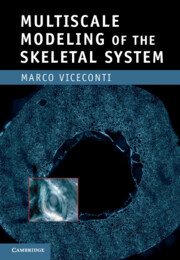6 - Cellular level
cell–matrix interaction
Published online by Cambridge University Press: 05 January 2012
Summary
A description of the bone extracellular matrix from a biochemical point of view and the specialized cellular types that permeate it, as well as their interaction as part of the mechanobiological interaction called bone remodeling.
Bone extracellular matrix
In connective tissues, the extracellular matrix is the extracellular part of tissue that provides structural support to the cells. The major part of bone mass is made of the bone extracellular matrix. The bone matrix is made of an inorganic part and an organic part: it is composed of a protein matrix, which contains embedded crystals of hydroxyapatite, a form of calcium phosphate. Bone-forming cells secrete the organic part, called osteoid, formed by collagen and other non-collagenous proteins. The osteoid can be laid down quite rapidly without any particular spatial organization, which produces woven bone, or more slowly in a more organized fashion, which produces lamellar bone. Once the osteoid is apposed, it starts to mineralize; inorganic materials precipitate on it, stiffening the tissue considerably.
Collagen
Approximately 90% of the weight of the bone organic matrix is collagen. This protein is very common in the human body (nearly a third of the whole protein mass). There are many different chemical types of collagen in the human body, but the most common in bones is type I; to which I shall refer in the following.
- Type
- Chapter
- Information
- Multiscale Modeling of the Skeletal System , pp. 124 - 153Publisher: Cambridge University PressPrint publication year: 2011



